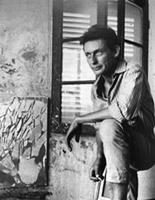
Bolin became widely celebrated for his ethereal landscape inspired abstraction imbued with sumptuous Mediterranean colours. Born in Stockholm in 1920 into a distinguished family of goldsmiths, suppliers to the Tsars and the Swedish Royal Family for three generations, Gustav Bolin was taken to Paris at the age of one; and he would live in France for the rest of his life. In 1938 he started working in the studio of Othon Friesz, but during the Occupation he moved to the South of France where he befriended André Lhote, as well as Garbell, Tal Coat and Rollier, with whom he exhibited at the Musée de Valence. In 1943 before returning to Paris, he made a pilgrimage through Provence in the footsteps of Cezanne and Van Gogh. For the rest of his life the landscape of the Midi, and the Côte d’Azur would become his obsession, and the subject of his enchanting abstract expression for which he became widely acclaimed.
Back in Paris following the Liberation he took a studio and immersed himself in the artistic milieu around the Café Dôme, becoming good friends with Giacometti and Nicolas de Stael, and in 1947 began exhibiting at the Salon de Mai. Drawn into the circle of artists around the avant-garde Galerie Pierre Loeb, he was given his first solo exhibition there in 1948. He subsequently showed at the Galerie Art Vivant in 1950, ’54, ’55, ’57, in the distinguished company of de Stael, Miro, Germain, Lanskoy and his old friend Tal Coat. Following this early success he was able to take a place in Antibes where he could work in the Mediterranean landscape he loved.
Bolin continued to participate in the Salon de Mai, and the Salon des Réalités Nouvelles, cementing his reputation as an evocative colorist. In 1960, ’61 and ’63 he was invited by the Galerie Charpentier to participate in the “Ecole de Paris” exhibitions; and at Galerie Kriegel 1962, ’63, ’65, ‘69. In 1963, ’67 and ’68 he exhibited at the David Findley Gallery in New York and further international exposure took place with shows at the Nichido Gallery in Tokyo, 1964, ’68 and ’69, this last coinciding with the Biennale of Tokyo. In 1973 he was given a major exhibition at the Musée Galliera in Paris. Over the following decades he continued to exhibit widely including a number of exhibitions in his native Sweden.
The artist’s work is now represented in various public collections including the Musée National d’Art Moderne, Paris, the Museum of Luxembourg, the Swedish Embassy (Paris) and the Department des Arts et des Lettres.